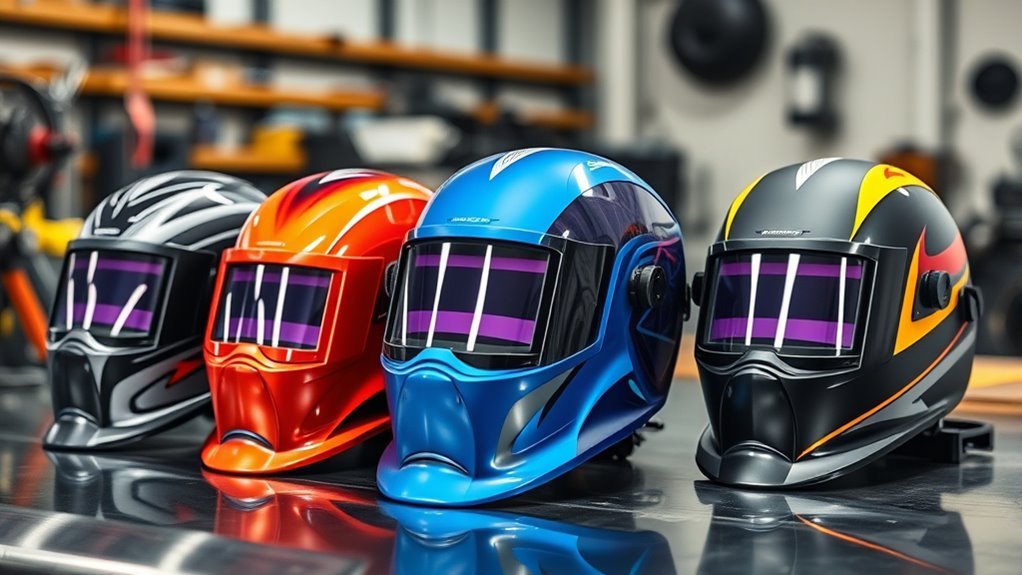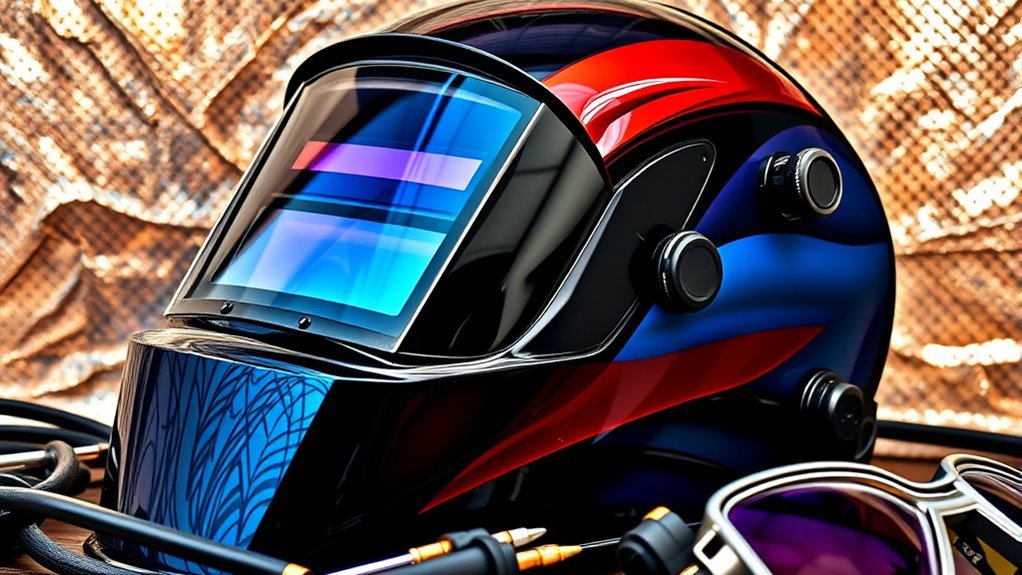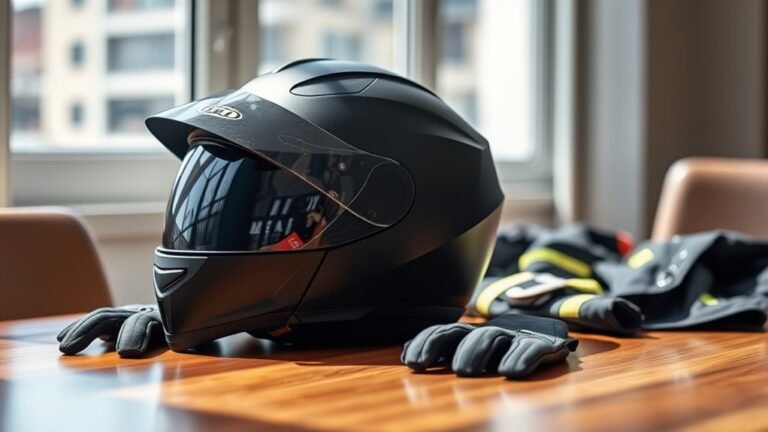Top Welding Helmets for Professional Welders
For top welding helmets, consider auto-darkening models for instant shade adjustments, featuring lens shades from 5 to 13. Look for lightweight options with quality padding and adjustable headgear for comfort during long jobs. Make sure helmets comply with safety standards like ANSI Z87.1 for UV and IR protection. If you want premium features, such as True Color Technology for enhanced visibility, there are high-end options available. Continue exploring to discover further insights and recommendations.
Key Features to Look for in a Welding Helmet

When you’re choosing a welding helmet, it’s essential to take into account several key features that can greatly impact your safety and performance. First, consider the welding helmet types available, such as fixed, auto-darkening, and passive helmets, each offering unique advantages. Auto-darkening helmets provide immediate lens shade adjustments, enhancing visibility and reducing eye strain. Next, evaluate the lens shade options; they range from 5 to 13, with higher numbers suitable for more intense welding processes. A helmet with a wider shade range offers flexibility for various applications. Additionally, check the helmet’s weight and comfort, as prolonged use demands a lightweight design. Finally, guarantee adequate ventilation to keep you cool during long sessions, allowing you to focus on your craft without distraction.
Best Auto-Darkening Welding Helmets

Although selecting the right auto-darkening welding helmet can seem intimidating, the best models are designed to enhance your welding experience through advanced features and superior protection. These helmets utilize cutting-edge auto darkening technology, allowing the lens to react instantly to welding arcs, providing ideal visibility and safety. Look for helmets made from durable welding helmet materials like polycarbonate or fiberglass, which offer both lightweight comfort and robust protection against sparks and heat. Features such as adjustable sensitivity and delay settings let you customize your experience, adapting to various welding processes. With options catering to different budgets and preferences, investing in a quality auto-darkening welding helmet will considerably improve your welding efficiency and safety, giving you the freedom to focus on your craft.
Top Fixed Shade Welding Helmets

When considering top fixed shade welding helmets, you’ll want to focus on their key features, such as lens clarity and weight distribution for comfort during long work hours. Popular brands in this category often comply with stringent safety standards, ensuring reliable protection against harmful UV and IR rays. Understanding these aspects will help you select the right helmet that meets both your needs and industry requirements.
Key Features Explained
While you may think all welding helmets are created equal, the key features of top fixed shade welding helmets set them apart regarding performance and safety. These helmets excel due to advancements in welding helmet technology and offer reliable protection for professional welders.
Here are three standout features to evaluate:
- Fixed Shade Levels: Generally available in shades 10 to 14, ensuring proper visibility while protecting your eyes.
- Durability: Constructed with high-quality materials to withstand harsh working conditions.
- Helmet Customization Options: Many models allow for personalized designs or features, giving you freedom in both function and style.
Investing in a top fixed shade helmet means prioritizing your safety and comfort in every welding task.
Popular Brands Overview
As you explore the market for top fixed shade welding helmets, you’ll find a variety of reputable brands that cater specifically to the needs of professional welders. Brands like Lincoln Electric and Miller Electric are often at the forefront, known for their durability and performance. In brand comparisons, you’ll see that both offer unique features, like Lincoln’s auto-darkening technology and Miller’s lightweight designs. Market trends indicate a rising demand for helmets that combine functionality with comfort, prompting brands to innovate continuously. Additionally, some newer entrants are gaining traction, emphasizing affordability without compromising quality. Understanding these dynamics can help you choose the right helmet, aligning with your specific welding requirements and preferences.
Safety Standards Compliance
Guaranteeing safety standards compliance is vital for any professional welder, especially when selecting top fixed shade welding helmets. Adhering to welding regulations guarantees you’re protected from various hazards while maintaining productivity. Here are three key aspects to take into account:
- Welding Regulations Overview: Familiarize yourself with the specific standards relevant to your region, such as ANSI, CSA, and ISO guidelines.
- Helmet Safety Certifications: Look for helmets certified by recognized bodies like ANSI Z87.1 or EN 175, which assure quality and safety performance.
- Impact Resistance Ratings: Confirm the helmet can withstand impacts, which is essential for your eye and face protection.
Welding Helmets With Advanced Safety Ratings
When selecting a welding helmet, it’s essential to choose one that meets ANSI safety standards for ideal protection. You’ll want to look for helmets with advanced impact resistance features, which can greatly reduce the risk of injury from flying debris. Understanding these safety ratings will help guarantee you’re equipped for the demands of professional welding.
ANSI Safety Standards Compliance
Welding helmets play an essential role in protecting professionals from various hazards, and compliance with ANSI safety standards is important for guaranteeing ideal safety and performance. To stay ahead in welding safety, consider these compliance regulations when selecting a helmet:
- ANSI Z87.1: This standard covers eye and face protection, guaranteeing your helmet meets essential impact and optical requirements.
- ANSI/ISEA 125: This guideline focuses on the performance of welding helmets, emphasizing resistance to radiation and heat.
- ANSI Z89.1: While primarily for head protection, this standard guarantees your helmet provides adequate support and protection during welding operations.
Choosing helmets that meet these standards not only enhances your safety but also supports your professional freedom and efficiency on the job.
Impact Resistance Features
While selecting a welding helmet, it’s vital to prioritize impact resistance features, as they directly influence your safety in hazardous environments. Helmets with advanced safety ratings undergo rigorous durability testing to guarantee peak performance. Look for models that incorporate superior shock absorption materials, which can greatly reduce the risk of injury from falling debris or accidental impacts.
| Feature | Description |
|---|---|
| Shock Absorption | Materials designed to disperse impact forces. |
| Durability Testing | Rigorous tests to guarantee long-lasting performance. |
| Safety Ratings | Compliance with ANSI and other safety standards. |
| Weight | Lightweight designs for comfort and mobility. |
Investing in a helmet with these features is vital for maintaining your freedom and safety on the job.
Lightweight and Comfortable Welding Helmets
Many professionals understand the significance of lightweight and comfortable welding helmets in enhancing productivity and safety. When you’re wearing a helmet for hours, it’s essential to choose one that doesn’t weigh you down or cause discomfort. Here are three key features to take into account:
- Lightweight Materials: Opt for helmets made from advanced polymers that minimize weight without sacrificing durability.
- Comfort Padding: Look for models with ample comfort padding which helps reduce pressure on your head while providing a snug fit.
- Adjustable Headgear: Helmets with adjustable headgear guarantee a tailored fit for various head sizes, enhancing overall comfort.
Investing in a lightweight and comfortable welding helmet not only boosts your efficiency but also allows you the freedom to focus on your work without distraction.
Best Budget Welding Helmets for Professionals
For professionals seeking quality without breaking the bank, finding the best budget welding helmets is essential. You’ll discover several affordable options that don’t compromise on safety or performance. Look for helmets with auto-darkening features, adjustable sensitivity, and a wide viewing area, which are vital for efficient welding. User reviews can guide you in selecting a model that offers durability and comfort, ensuring you’re protected during long hours. Brands like Antra and Lincoln Electric often receive praise for their reliability and performance at lower price points. By investing in a well-reviewed budget helmet, you can achieve the freedom to work effectively without exceeding your budget, keeping both your wallet and your safety in mind.
High-End Welding Helmets With Enhanced Features
High-end welding helmets are engineered with advanced lens technology that enhances visibility and reduces eye strain during prolonged use. You’ll find features like auto-darkening filters that adjust in real-time, ensuring ideal protection without compromising your line of sight. Additionally, ergonomic design elements improve comfort and fit, allowing for extended wear without fatigue.
Advanced Lens Technology
As you explore the world of advanced welding helmets, you’ll discover that cutting-edge lens technology plays a pivotal role in enhancing both safety and performance. High-end models often incorporate features that guarantee superior vision and protection, making your welding experience more efficient. Here are three critical aspects to take into account:
- Adaptive Lens Technology: This feature automatically adjusts the lens shade based on the brightness of the welding arc, providing optimal visibility.
- Lens Durability: High-quality lenses resist scratches and impacts, assuring longevity and clarity over time.
- True Color Technology: This innovation enhances color perception, allowing you to see the details of your work more clearly, reducing strain during long sessions.
Investing in helmets with these advanced technologies empowers you to work confidently and effectively.
Ergonomic Design Features
While selecting a welding helmet, considering ergonomic design features is vital to enhancing comfort and productivity during long welding sessions. High-end helmets often come with adjustable headgear, allowing you to customize the fit according to your head size and shape. This feature guarantees a snug yet comfortable fit, reducing fatigue over extended use. Additionally, effective weight distribution is fundamental; helmets designed with a balanced weight profile alleviate pressure on your neck and shoulders. Look for models that incorporate padding and ventilation systems, as these contribute to overall comfort. By prioritizing ergonomic features, you’ll experience less strain and more freedom to focus on your work, leading to improved performance and job satisfaction.
Helmets With Superior Visibility and Clarity
When you’re working in environments with intense light and potential hazards, having a welding helmet with superior visibility and clarity is crucial for both safety and precision. Advanced welding lens technology and visibility enhancements can greatly improve your work experience. Here are three top features to look for:
- Auto-Darkening Lenses: These lenses adjust automatically to varying light conditions, providing ideal clarity.
- Wide Viewing Area: A larger viewing window enhances peripheral vision, allowing you to monitor your surroundings better.
- True Color Technology: This feature offers a natural color perception, reducing eye strain and improving weld quality.
Investing in a helmet with these qualities not only enhances your performance but also guarantees your safety while you work freely and effectively.
Additional Accessories for Welding Helmets
A welding helmet’s performance can be greatly improved with the right accessories, providing added comfort and functionality for professional welders. Investing in quality replacement lenses is essential; they not only improve visibility but also guarantee safety by protecting your eyes from harmful UV rays. You’ll find a variety of lens shades available, allowing you to customize your helmet to your specific welding tasks. Additionally, helmet accessories like sweatbands, adjustable headgear, and external magnifying lenses can considerably enhance your overall experience. These accessories offer better fit, reduce fatigue, and improve focus on your work. By outfitting your helmet with the right components, you can maximize your efficiency and comfort, giving you the freedom to concentrate on the task at hand.
Maintenance Tips for Your Welding Helmet
To guarantee your welding helmet performs at its best over time, regular maintenance is essential. Neglecting this can affect visibility and safety during your work. Follow these tips for ideal helmet upkeep:
Regular maintenance of your welding helmet is crucial for optimal performance and safety during your work.
- Helmet Cleaning: Regularly clean the exterior and interior with a soft cloth and mild soap. Avoid harsh chemicals that could damage the materials.
- Lens Replacement: Inspect the lens frequently for scratches or cracks. Replace it immediately to guarantee clear visibility and protection.
- Strap Adjustment: Check the headgear and straps for wear and tear. Adjust or replace as necessary to maintain a secure fit.
Frequently Asked Questions
Can I Use a Welding Helmet for Other Types of Work?
Yes, you can use a welding helmet for other types of work, but safety precautions are essential. Its protective features, like shielding from UV rays and sparks, make it suitable for tasks like metal cutting or grinding. However, verify it meets the specific safety requirements of those activities. Remember, while it offers great protection, it’s designed primarily for welding, so consider alternative uses with caution and proper equipment to maintain safety.
How Often Should I Replace My Welding Helmet?
You should replace your welding helmet every 3 to 5 years, but how often do you really inspect it for damage? Regularly check for signs of helmet damage, like cracks, scratches, or faded lenses. These issues can compromise protection and visibility. If you notice any significant wear or malfunction, it’s time for a replacement. Prioritizing helmet replacement frequency guarantees your safety and comfort while allowing you the freedom to focus on your work.
What Is the Lifespan of an Auto-Darkening Lens?
The lifespan of an auto-darkening lens typically ranges from 3 to 5 years, depending on usage and lens maintenance. With proper care, such as regularly cleaning the lens and avoiding exposure to extreme temperatures, you can extend its life. Remember that auto darkening technology can degrade over time, affecting its responsiveness. It’s essential to inspect your helmet regularly, ensuring maximum safety and performance while you work freely.
Are Welding Helmets Compatible With Prescription Glasses?
Yes, welding helmets can be compatible with prescription glasses, but achieving ideal helmet comfort is vital. Many helmets have enough space to accommodate prescription lenses, but you might encounter pressure points. It’s essential to try on different models to find one that fits comfortably over your glasses without compromising safety. Additionally, consider using flip-up or magnifying lenses to enhance vision while wearing your helmet, ensuring you work with precision and confidence.
How Do I Properly Clean My Welding Helmet?
To properly clean your welding helmet, start with gentle cleaning techniques. Use a microfiber cloth and mild soap solution for the exterior, avoiding abrasive materials. For the lens, use a dedicated lens cleaner or a mixture of water and vinegar. Regular maintenance tips include checking for scratches and replacing the lens when necessary. Remember to avoid chemicals that could damage the helmet’s materials, ensuring your gear remains in top condition for peak performance.






